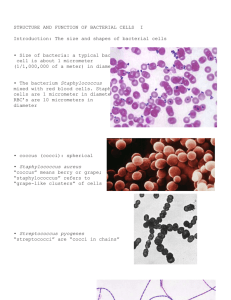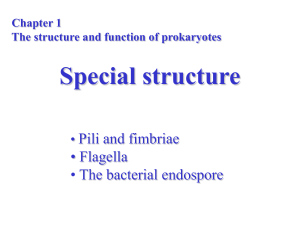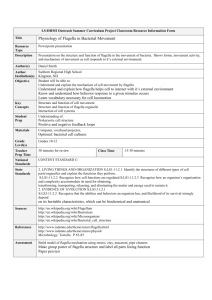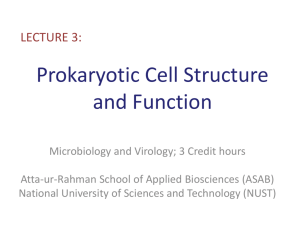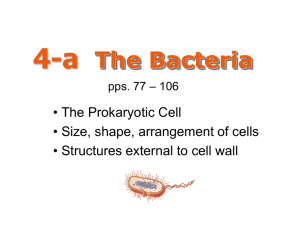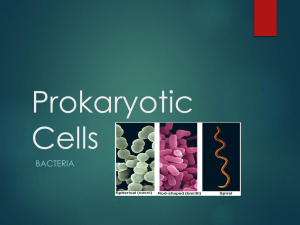Medical Bacteriology
advertisement
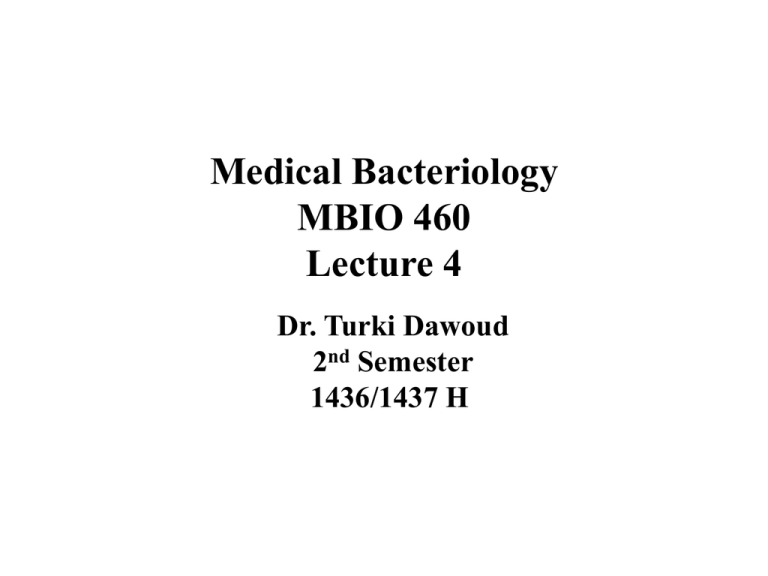
Medical Bacteriology MBIO 460 Lecture 4 Dr. Turki Dawoud 2nd Semester 1436/1437 H OTHER CELL SURFACE STRUCTURES AND INCLUSIONS 4. 9 Cell Surface Layers, Pili, and Fimbriae • Many prokaryotic organisms secrete slimy or sticky materials on their cell surface. • These materials consist of either polysaccharide or protein. • These are not considered part of the cell wall because they do not confer significant structural strength on the cell. • The terms “capsule” and “slime layer” are used to describe these layers. Capsules and Slime Layers • Capsules and slime layers may be thick or thin and rigid or flexible, depending on their chemistry and degree of hydration • If the material is organized in a tight matrix it is called a capsule (Figure 4.28) • If the material is more easily deformed, it will not exclude particles and is more difficult to see; this form is called a slime layer. • In addition, capsules are typically firmly attached to the cell wall, whereas slime layers are loosely attached and can be lost from the cell surface. Polysaccharide layers have several functions in bacteria: • Surface polysaccharides assist in the attachment of microorganisms to solid surfaces. • Extracellular polysaccharides play a key role in the development of biofilms. • Polysaccharide outer layers play other roles as well. For example, encapsulated pathogenic bacteria are typically more difficult for phagocytic cells of the immune system to recognize and subsequently destroy. • In addition, because outer polysaccharide layers bind a significant amount of water, it is likely that these layers play some role in resistance of the cell to desiccation. Fimbriae and Pili • Fimbriae and pili are filamentous structures composed of protein that extend from the surface of a cell and can have many functions. • Fimbriae (Figure 4.29) enable organisms to stick to surfaces, including animal tissues in the case of some pathogenic bacteria, or to form pellicles (thin sheets of cells on a liquid surface) or biofilms on surfaces. • Well-known among human pathogens in which these structures assist in the disease process include Salmonella species (salmonellosis), Neisseria gonorrhoeae (gonorrhea), and Bordetella pertussis (whooping cough). Figure 4.29: Fimbriae. Electron micrograph of a dividing cell of Salmonella typhi, showing flagella and fimbriae. A single cell i about 0.9 µm wide. • Pili are similar to fimbriae but are typically longer structures, and only one or a few pili are present on the surface of a cell. • Because pili can be receptors for certain types of viruses, they can best be seen under the electron microscope when they become coated with virus particles (Figure 4.30). • Although they may attach to surfaces as do fimbriae, pili also have other functions. A very important function is facilitating genetic exchange between prokaryotic cells in the process of conjugation • Many classes of pili are known, distinguished by their structure and function. One class, called type IV pili, performs an unusual form of cell motility called twitching motility. Type IV pili are 6 nm in diameter and can extend for several micrometers away from the cell surface Figure 4.30 Pili. The pilus on an Escherichia coli cell that is undergoing genetic transfer with a second cell is revealed by the viruses that have adhered to it. The cells are about 0.8 µm wide 1. 10 Cell Inclusions • Granules or other inclusions are often present in prokaryotic cells. • Inclusions function as energy reserves or as a reservoir of structural building blocks such as carbon. • Inclusions can often be seen directly with the light microscope and are typically enclosed by structurally atypical membranes that partition them off in the cell. • Storing carbon or other substances in an insoluble form is advantageous to the cell because it reduces the osmotic stress that would be encountered if the same amount of the substance was stored in soluble form within the cytoplasm. Carbon Storage Polymers • One of the most common inclusion bodies in prokaryotic organisms consists of poly-βhydroxyl-butyric acid (PHB), a lipid that is formed from β-hydroxbutyric acid units Figure 4.31 • Another storage product is glycogen, which is a polymer of glucose. Figure 4.31 Poly-β-hydroxybutyrate (PHB). Polyphosphate and Sulfur • Many microorganisms accumulate inorganic phosphate (PO42−) in the form of granules of polyphosphate. • These granules can be degraded and used as sources of phosphate for nucleic acid and phospholipid biosyntheses and in some organisms can be used to make the energy-rich compound ATP. • Elemental sulfur may accumulate inside the cell in readily visible globules. Figure 4.32: Sulfur globules. Brightfield photomicrograph of cells of the purple sulfur bacterium Isochromatium buderi. The intracellular inclusions are sulfur globules formed from the oxidation of hydrogen sulfide (H2S). A single cell measures 4 × 7 µm. Magnetic Storage Inclusions: Magnetosomes • Some bacteria can orient themselves specifically within a magnetic field because they contain magnetosomes. • These structures are intracellular particles of the iron mineral magnetite–Fe3O4 (Figure 4.33). • The major function of magnetosomes is unknown. Gas Vesicles • Some prokaryotes are planktonic, meaning that they live a floating existence within the water column of lakes and the oceans. These organisms can float because they contain gas vesicles. General Structure of Gas Vesicles: • Gas vesicles are spindle-shaped gasfilled structures made of protein; they are hollow yet rigid and of variable length and diameter. • Gas vesicles in different organisms vary in length from about 300 to more than 1000 nm and in width from 45 to 120 nm, but the vesicles of a given organism are more or less of constant size. Figure 4.35 Gas vesicles. 4.12 Endospores • Certain species of Bacteria produce structures called endospores (Figure 4.38) during a process called sporulation. • Endospores (the prefix “endo” means “within”) are highly differentiated cells that are extremely resistant to heat, harsh chemicals, and radiation. • Endospores function as survival structures and enable the organism to endure difficult times, including but not limited to extremes of temperature, drying, or nutrient depletion. • Endospores can thus be thought of as the dormant stage of a bacterial life cycle: vegetative cell → endospore → vegetative cell. Figure 4.38 :The bacterial endospore. Phase-contrast photomicrographs illustrating endospore morphologies and intracellular locations in different species of endospore-forming bacteria. • Endospores are also ideal structures for dispersal of an organism by wind, water, or through the animal gut. Endospore-forming bacteria are found most commonly in the soil, and the genera Bacillus and Clostridium are the best studied of endospore-forming bacteria Endospore Structure • The endospore is structurally more complex in that it has many layers that are absent from the vegetative cell. • The outermost layer is the exosporium, a thin protein covering. • Within this are the spore coats, composed of layers of spore-specific proteins (Figure 4.41b). • Below the spore coat is the cortex, which consists of loosely cross-linked peptidoglycan, and inside the cortex is the core, which contains the core wall, cytoplasmic membrane, cytoplasm, nucleoid, ribosomes, and other cellular essentials. • Thus, the endospore differs structurally from the vegetative cell primarily in the kinds of structures found outside the core wall. Figure 4.41 Structure of the bacterial endospore. (a) Transmission electron micrograph of a thin section through an endospore of Bacillus megaterium. (b) Fluorescent photomicrograph of a cell of Bacillus subtilis undergoing sporulation. The green area is due to a dye that specifically stains a sporulation protein in the spore coat MICROBIAL LOCOMOTION • We examine here the two major types of cell movement, swimming and gliding. We then consider how motile cells are able to move in a directed fashion toward or away from particular stimuli (phenomena called taxes) and present examples of these simple behavioral responses 1.13 Flagella and Motility • Bacterial flagella are long, thin appendages free at one end and attached to the cell at the other end. Bacterial flagella are so thin (15–20 nm, depending on the species) that a single flagellum can be seen with the light microscope only after being stained with special stains that increase their diameter. Figure 4.45 Bacterial flagella as observed by negative staining in the transmission electron microscope. (a) A single polar flagellum. (b)Peritrichous flagella. Figure 4.44 Bacterial flagella. Light photomicrographs of prokaryotes containing different arrangements of flagella. Cells are stained with Leifson flagella stain. (a)Peritrichous. (b) Polar. (c) Lophot richous. • In polar flagellation, the flagella are attached at one or both ends of the cell • Occasionally a tuft (group) of flagella may arise at one end of the cell, a type of polar flagellation called lophotrichous (“lopho” means “tuft”; “trichous” means “hair”) • When a tuft of flagella emerges from both poles, flagellation is called amphitrichous. in peritrichous flagellation. Figure 4.45 Bacterial flagella as observed by negative staining in the transmission electron microscope. (a) A single polar flagellum. (b) Peritrichous flagella. Figure 4.44 Bacterial flagella. Light photomicrographs of prokaryotes containing different arrangements of flagella. Cells are stained with Leifson flagella stain. (a)Peritrichous. (b) Polar. (c) Lophot richous. Flagellar Movement • A flagellum consists of several components and moves by rotation, much like a propeller of a boat motor. 1.14 Gliding Motility • Some prokaryotes are motile but lack flagella. • These non-swimming yet motile bacteria move across solid surfaces in a process called ”Gliding”. • Unlike flagellar motility, in which cells stop and then start off in a different direction, gliding motility is a slower and smoother form of movement. • Gliding motility is widely distributed among Bacteria. • The gliding movement itself–up to 10 µm/sec in some gliding bacteria–is considerably slower than propulsion by flagella but still offers the cell a means of moving about its habitat. • Gliding prokaryotes are filamentous or rod-shaped cells and the gliding process requires that the cells be in contact with a solid surface. • The morphology of colonies of a typical gliding bacterium (colonies are masses of bacterial cells that form from successive cell divisions of a single cell, Section 5.3) are distinctive, because cells glide out and move away from the center of the colony (Figure 4.51c). Figure 4.51 Gliding bacteria Cell Motion as a Behavioral Response: Microbial Taxes • Prokaryotes often encounter gradients of physical or chemical agents in nature and have evolved means to respond to these gradients by moving either toward or away from the agent. Such a directed movement is called a taxis (plural, taxes). • “Chemotaxis”, a response to chemicals, and ”Phototaxis”, a response to light, are two well-studied taxes. QUESTIONS??

